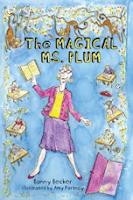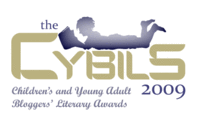
This Cybils nomination was a disappointment to me. Bonny Becker, author of award-winning Visitor for Bear and the very sweet Birthday for Bear (to be reviewed when I get to easy readers) has also written a beginning chapter book. Magical Ms. Plum has a Mrs. Piggle-Wiggleish plot, but just doesn't hold up to inspection.
Ms. Plum, third-grade teacher, has the best classroom. She has classroom pets, lots of plum-themed stuff, and best of all...a magic supply closet. When students are sent to get something out, they always get a little extra; a magical animal that happens to be what they need the most at the moment. So far so good.
But the pairings of misbehaving children and animals are....weird. First, we have a tomboyish little girl who is very scornful of a pink-loving girly girl. Tomboyish Tashala gets a miniature pony out of the closet and is thrilled; until it fills her desk with poop and she realizes a pony is work. Pink-loving Mindy turns out to have four brothers and is used to changing diapers and is the perfect person for the pony.
The next pairing is constant-talker Eric Soderberg who can't resist finishing people's sentences, jokes, and answering every question. He gets a little parrot who tells everyone what he's thinking. Clumsy, quiet Darma who has no friends, gets a "squad of bright-eyed squirrels" who will help only her and nobody else. The other students decide that since she has "cool stuff done for her" she is cool...and Darma now has lots of friends. Jovi, an immigrant, is very uncertain and shy. He gets a wild hawk and gains confidence by setting it free. Jeremy is "the gloomiest kid in Ms. Plum's room". He always dresses in black, never smiles, and quotes Edgar Allan Poe. He gets a raven that says pig snout until he laughs. The next day he arrives wearing brightly colored clothes and smiling. Brad, who likes to play with the older kids and is tough, gets a fun-loving little monkey who helps him win some games. Emiko, who always looks on the bright side even when there isn't one, gets a nasty alligator she insists is a poodle; until she takes off her glasses and sees what it really is.
Complaining Becky gets a little donkey that she and her classmates load with nasty notes; but when he looks miserable they take them all out again.Worrier Nadia gets a cute kitten that even Lucy, who tells her all the bad things she has to worry about, can't make her dislike.
There's a second plot running through the episodes of Carlos, who's book-smart but people-dumb and so desperately wants an animal that first he tries to imitate the problems of the kids who get animals, then he starts snooping in other kids' stuff to make himself feel better, then sneaks into the closet. He gets a nasty weasel that only he can see and the promise of another chance someday.After each chapter, there's an italicized section. Sometimes it's a continuation of the chapter's story, sometimes it's about the kids trying to tell others about the magic and being unable to let out the secret.
There's a second plot running through the episodes of Carlos, who's book-smart but people-dumb and so desperately wants an animal that first he tries to imitate the problems of the kids who get animals, then he starts snooping in other kids' stuff to make himself feel better, then sneaks into the closet. He gets a nasty weasel that only he can see and the promise of another chance someday.After each chapter, there's an italicized section. Sometimes it's a continuation of the chapter's story, sometimes it's about the kids trying to tell others about the magic and being unable to let out the secret.
The magic and mini-animals are cute and there's a definite flavor of Mrs. Piggle-Wiggle's magic cures, but the story just doesn't work. There's too many episodes, leaving the stories of the different kids feeling half-finished and the cures (and problems) are illogical and confusing. Sometimes the magic seems to be just for fun; as in one of the italicized sections where everyone gets magic candy from the closet. Sometimes the fault or problem the magic is "curing" isn't really a fault - Jeremy's dark demeanor could be anything from incipient goth style to depression to symptoms of abuse. Handing him a silly raven and having him wear bright clothes instead of black is an odd and disturbing way to handle his "problem". Kids who have been ignored and picked on are pathetically grateful to suddenly have friends; enemies casually pass over past insults without apologies or explanations. The sketch-style gray and white illustrations seem to be trying to add a realistic feel to the straggling plot, but only manage to add an even more surreal element to episodes like the miniature monkeys bringing in the "candy cart".
Ms. Becker's flap copy says she "hopes kids who read this book will feel less afraid of making mistakes, and will see that stumbles are a part of how everyone grows and figures things out" but having a nasty invisible weasel follow you around isn't exactly an incentive to make mistakes. And the idea that a little magic will mend kids' faults doesn't translate to real world lessons in social interaction.
 Verdict: Kids looking for stories of real kids making real mistakes will want to read some of the other funny and concisely plotted stories out there; like Keena Ford and Roscoe Riley while those looking for a little bit of magic will want stories with more logic and less haphazard moralizing.
Verdict: Kids looking for stories of real kids making real mistakes will want to read some of the other funny and concisely plotted stories out there; like Keena Ford and Roscoe Riley while those looking for a little bit of magic will want stories with more logic and less haphazard moralizing.ISBN: 978-0375856372; Published September 2009 by Knopf; Borrowed from the library
No comments:
Post a Comment